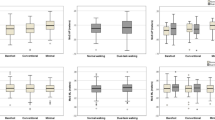Summary.
Footwear is supposed to have influence on postural control and is a potential aspect to address in the prevention of falls in the elderly. This study aimed to show whether measurements of static balance and gait are different with habitual shoes compared to new special senior shoes with different heel height and whether these results change after adaptation. In a randomized controlled intervention study, 26 subjects (median age 87 years) were recruited from two nursing homes and one facility of assisted living. Measurements of static balance and gait were performed with habitual shoes and two types of new special senior shoes differing in heel height. Measurements were repeated after five weeks. There was no difference in static balance and gait with habitual shoes compared to either of the new footwear offered. Results of performance with higher heels were not different compared to lower heels. No further effect of adaptation after wearing a new shoe over five weeks could be demonstrated. With respect to static and dynamic balance, there seems to be a wide range of acceptable footwear as long as the heel height is below a critical value. A standardized shoe can be used in the assessment of balance because the effect of adaptation can be neglected.
Zusammenfassung.
Mehrere Untersuchungen haben den Einfluss von unterschiedlichem Schuhwerk auf die Balance und das Gangbild gezeigt. Dies zeigt die Bedeutung der Schuhversorgung im Kontext der Sturzprävention bei älteren Menschen. Daher sollte untersucht werden, ob das Tragen eines speziellen Seniorenschuhs Auswirkungen auf die Standbalance und das Gangbild hat. Weiterhin sollte die Gewöhnung an einen neuen Schuh beschrieben werden. In einer randomisierten und kontrollierten Untersuchung wurden bei 26 ältere Bewohnerinnen aus zwei Pflegeheimen und einer Einrichtung des betreuten Wohnens (mittleres Alter 87 Jahre) die Balance im Stand und das Gangbild untersucht. Die Messungen wurden mit dem habituellen Schuh und zwei speziellen Seniorenschuhen, die nur in der Absatzhöhe differierten durchgeführt und nach fünf Wochen wiederholt. Bezüglich der unterschiedlichen Schuhtypen konnten keine Unterschiede in der Standbalance und dem Gangbild gezeigt werden. Auch änderten sich die erhobenen Parameter nicht nach fünf Wochen Gewöhnung an einen neuen Schuh. Die Untersuchung legt die Vermutung nahe, dass Schuhe sich nicht negativ auf die Standbalance und das Gangbild auswirken, soweit sie einen festen Fersenhalt haben und die Absatzhöhe nicht zu hoch ist. Weiterhin kann gefolgert werden, dass sich die Benutzung eines „Standardschuhs” bei diesen Untersuchungen nicht auf die Ergebnisse auswirkt.
Similar content being viewed by others
Author information
Authors and Affiliations
Additional information
Received: 4 September 2002 Accepted: 29 October 2002
Acknowledgment The “active control” shoes used in this study were provided by Orthotech GmbH, Gauting, Germany.
Correspondence to Ulrich Lindemann
Rights and permissions
About this article
Cite this article
Lindemann, U., Scheible, S., Sturm, E. et al. Elevated heels and adaptation to new shoes in frail elderly women. Z Gerontol Geriat 36, 29–34 (2003). https://doi.org/10.1007/s00391-003-0133-x
Issue Date:
DOI: https://doi.org/10.1007/s00391-003-0133-x




